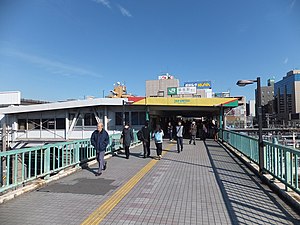Soga Station
This article needs additional citations for verification. (January 2014) |
35°34′53.33″N 140°07′52.10″E / 35.5814806°N 140.1311389°E
Soga Station 蘇我駅 | |
|---|---|
 West exit, December 2011 | |
| General information | |
| Location | 2 Imai, Chūō, Chiba, Chiba (千葉県千葉市中央区今井二丁目) Japan |
| Operated by |
|
| Line(s) |
|
| Connections |
|
| History | |
| Opened | 1896 |
| Passengers | |
| FY2009[citation needed] | 38,945 daily |
Soga station (蘇我駅, Soga-eki) is a railway station in Chūō-ku, Chiba, Japan, operated by the East Japan Railway Company (JR East) and the Keiyō Rinkai Railway Company.
Lines
Soga station is served by the following three JR East lines.
It is the northern terminal station for the Uchibō Line and is 3.8 kilometers from the northern terminus of the Sotobō Line at Chiba Station. It is 43.0 kilometers from the terminus of the Keiyō Line at Tokyo Station.
The station is also the starting point of the Keiyō Rinkai Railway Rinkai Main Line. There is a direct connection between the trains of the Rinkai Main Line and JR trains.
Station layout
Soga is an elevated station with an elevated station building, three island platforms and a total of six passenger lines. Freight lines are located to the side of the first platform, and the Keiyō Rinkai Railway office is located to the side of these. The station is staffed with personnel from both companies. It includes a Midori no Madoguchi staffed ticket office and automatic ticket gates.
Platforms

| 1 | ■Uchibō Line, ■Sotobō Line | for Chiba and Tokyo |
| 2 | ■Uchibō Line, ■Sotobō Line | for Chiba and Tokyo |
| ■from the Uchibo Line and the Sotobo Line to the Keiyō Line | for Kaihimmakuhari, Minami-Funabashi, Maihama, Shin-Kiba, and Tokyo | |
| 3・4 | ■Keiyō Line (starting Soga) | for Kaihimmakuhari, Minami-Funabashi, Maihama, Shin-Kiba, and Tokyo |
| 5 | ■Uchibō Line | for Goi, Kisarazu, Kimitsu, Tateyama, and Awa-Kamogawa (including through trains from the Keiyo Line) |
| ■Sotobō Line | for Ōami, Togane, Naruto, Mobara, Katsuura, and Awa-Kamogawa (including through trains from the Keiyo Line) | |
| 6 | ■Sotobō Line | for Ōami, Togane, Naruto, Mobara, Katsuura, Awa-Kamogawa |
| ■Uchibō Line | for Goi, Kisarazu, Kimitsu, Tateyama, and Awa-Kamogawa |
- Lines 3 and 4 terminate at this station.
- During the morning rush hour and certain other times, two different trains bound for Tokyo, namely the train connecting to the Sōbu Line Rapid via the Sotobō Line, and the Keiyō Line trains (via Kaihimmakuhari and Shin-Kiba) leave from the same platform (platform 2).
Adjacent stations
| « | Service | » | ||
|---|---|---|---|---|
| Keiyō Line | ||||
| Shin-Kiba | Commuter Rapid | Hamano (Uchibō Line) Kamatori (Sotobō Line) | ||
| Chibaminato | Keiyō Line Rapid | Hamano (Uchibō Line) Kamatori (Sotobō Line) | ||
| Chibaminato | Local | Hamano (Uchibō Line) Kamatori (Sotobō Line) | ||
| Sotobō Line | ||||
| Hon-Chiba | Sōbu Line Rapid | Kamatori | ||
| Shin-Kiba (Keiyō Line) | Commuter Rapid | Kamatori | ||
| Chibaminato (Keiyō Line) | Keiyō Line Rapid | Kamatori | ||
| Hon-Chiba Chibaminato (Keiyō Line) |
Local | Kamatori | ||
| Uchibō Line | ||||
| Hon-Chiba | Sōbu Line Rapid | Hamano | ||
| Shin-Kiba (Keiyō Line) | Commuter Rapid | Hamano | ||
| Chibaminato (Keiyō Line) | Keiyō Line Rapid | Hamano | ||
| Hon-Chiba Chibaminato (Keiyō Line) |
Local | Hamano | ||
History
Soga Station opened on January 20, 1896.[1] The station became part of JR East on the division and privatization of JNR on April 1, 1987.[1] The Keiyō Line opened on December 1, 1988.
Bus routes
- Chiba Chuo Bus
- Kominato Tetsudō Bus
- Askabus
- Keikyu Bus (Haneda Airport Limousine Bus (same direction as the Kominato Tetsudo Bus))
References
- ^ a b Ishino, Tetsu, ed. (1998). 停車場変遷大辞典 国鉄・JR編 [Station Transition Directory - JNR/JR]. Vol. II. Japan: JTB. p. 613. ISBN 4-533-02980-9.
